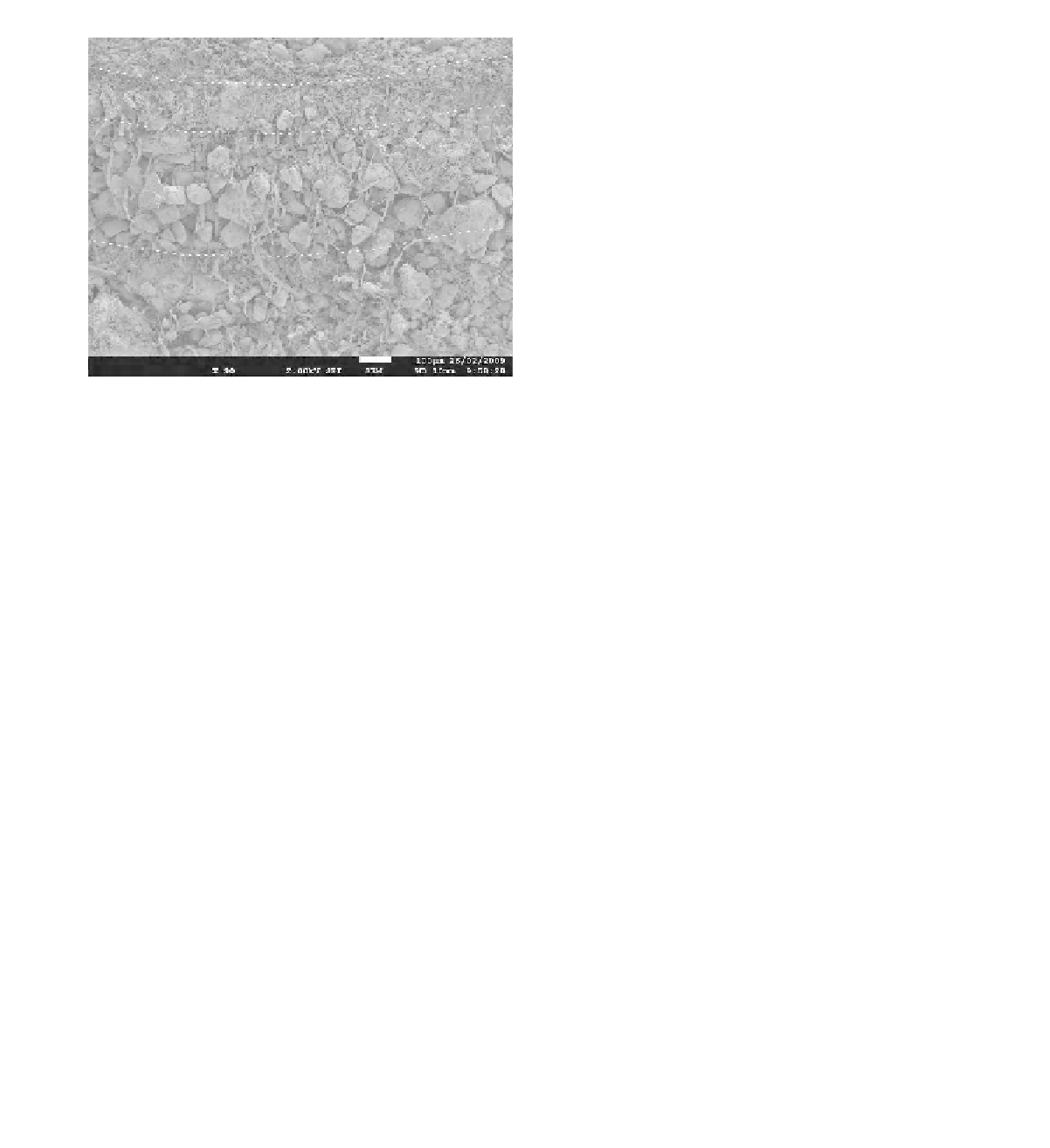Geoscience Reference
In-Depth Information
pond. The frictional drag on overland flow would be
considerably greater than for smooth crusts. Rugose
lichen and bryophyte crusts are often quite leathery,
and able to deform under a load without tearing or
rupturing.
(a)
(b)
Pinnacled crusts
. These are found in drylands where soil
freezing occurs, and the deformation of the surface re-
sults in very marked surface microrelief, measured in
cm. Overland flow between the prominent peaks and
ridges of the crust surface may contribute to the devel-
opment of the marked surface features (Belnap, 2006).
Pinnacled crusts are quite fragile, and are readily dam-
aged by crushing when exposed to pedestrian traffic or
livestock grazing. Figure 7.9 shows a pinnacled crust
in Utah, USA.
(c)
Figure 7.6
Cross-section of the uppermost part of a soil from
western NSW Australia, colonised by cyanobacteria. The large
particles in zone (b) are silts and are enmeshed by algal fila-
ments. The soil surface (a) is enriched in fine silts and clays
and the deepest zone (c) shows a less extensive mesh of bi-
ological filaments and poorer sorting of the mineral particles.
Image by the Monash Centre for Electron Microscopy.
Rolling crusts
. These are similar to pinnacled crusts,
but greater crust biomass (related to better moisture
conditions) limits the amount of deformation during
soil freezing, yielding a surface with less dramatic
microrelief.
7.5.9
Effects of biological soil crusts on
infiltration and overland flow
numerically or quantitatively based. Further, the classi-
fication is simply a morphologic one, since there is no
evidence that the different classes are internally coherent
and functionally significant in terms of differing infiltra-
tion or other process outcomes. The Belnap classification
describes four classes of crust:
There has been considerable research interest in the effects
of BSCs on surface water balance via infiltration and over-
land flow. The crusts are often darker than the mineral soil
surface where crusts are not present, and this can result
in soil temperatures being up to 14
◦
C warmer than un-
crusted sites nearby (Belnap, Prasse and Harper, 2001).
This may drive greater evaporative losses from the soil.
Additionally, some crusts are mildly hydrophobic (Yair,
2001) and in addition it is suspected that the additional
extracellular materials added to the void spaces between
mineral particles may reduce permeability and force more
rain to be partitioned into surface ponding and overland
flow. This effect may be exacerbated by the swelling of
the crust organisms when wet. Cyanobacterial sheaths can
very rapidly absorb water equivalent to 12 times their dry
weight and expand in volume by 10 times (Belnap and
Gardner, 1993; Yair, 2001). Crusts comprised principally
of cyanobacteria often form quite smooth surfaces, and
this would facilitate overland flow.
In contrast, crusts dominated by lichens and bryophytes
are often quite rough (rugose), containing ridges and de-
pressions of cm amplitude and many voids where water
can be held (Figure 7.10). These would certainly increase
the capacity of the surface to pond and detain water and
Smooth crusts
(Figure 7.7). These crusts, dominated by
cyanobacteria colonising the uppermost mm or so of the
soil, occur where the soil is not deformed by freezing
during winter. The surface tends to be quite smooth,
with a low roughness drag on overland flow. How-
ever, these crusts commonly exhibit polygonal fracture
systems caused by repeated shrinkage after rain. The
polygonally cracked crust is typically made up of plates
that are on average six-sided, which is consistent with
this morphology being a space-filling one caused by
shrinkage and swelling. Because the surface dries out
and shrinks more rapidly than the slightly deeper ma-
terials, the polygonal plates curl at the edges to form a
pedicled structure (i.e. separated from the soil except
for a relatively small support that remains attached),
and in this state the surface roughness is greater.
Rugose crusts
(Figure 7.8). These contain more lichens
and bryophytes than the smooth crusts, and typify lo-
cations with slightly better moisture availability. The

